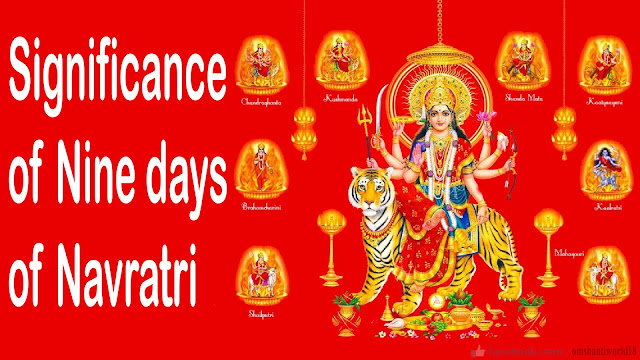Significance of Nine days of Navratri
As its name suggests, “Navratri” is a festival which is celebrated for nine days with immense joy and religious fervor throughout the country.

Among all the 9 days of navratri, each day is devoted to the 9 different forms of the deity Durga. Goddess Durga is worshiped under 9 distinct names for 9 days of Navratri. The Goddess takes up a new look, a fresh character and a new responsibility each day.
Goddess Durga, the epitome of power or shakti, is worshiped during Navratri symbolizing victory of positivity over negativity. It is believed the goddess had nine forms and she is worshiped in these forms during the nine-night festival. These nine forms are:
1. Shailputri
2. Brahmacharini
3. Chandraghanta
4. Kushmanda
5. Skandmata
6. Katyayani
7. Kaalratri
8. Mahagauri
9. Siddhidatri
The significance of each day in navratri also discloses the religious significance of this nine-day-festival.During the nine days of Navratri, feasting and fasting take precedence over all normal daily activities amongst the Hindus.
1st - 3rd day of Navratri
On the first day of the Navratri, a small bed of mud is prepared in the puja room of the house
and barley seeds are sown on it. On the tenth day, the shoots are about 3 5 inches in length. After the
puja, these seedlings are pulled out and given to devotees as a blessing from god. These initial
days are dedicated to Durga Maa, the Goddess of power and energy. Her various manifestations,
Kumari, Parvati and Kali are all worshiped during these days. They represent the three different
classes of womanhood that include the child, the young girl and the mature woman.
4th - 6th day of Navratri
During these days, Lakshmi Maa, the Goddess of peace and prosperity is worshiped. On the
fifth day which is known as Lalita Panchami, it is traditional, to gather and display all literature
available in the house, light a lamp or diya to invoke Saraswati Maa, the Goddess of knowledge
and art.
7th - 8th day of Navratri
These final days belong to Saraswati Maa who is worshipped to acquire the spiritual knowledge.
This in turn will free us from all earthly bondage. But on the 8th day of this colorful festival,
yagna (holy fire) is performed. Ghee (clarified butter), kheer (rice pudding) and sesame seeds
form the holy offering to Goddess Durga Maa.
Mahanavami
The festival of Navratri culminates in Mahanavami. On this day Kanya Puja is performed. Nine
young girls representing the nine forms of Goddess Durga are worshiped. Their feet are washed
as a mark of respect for the Goddess and then they are offered new clothes as gifts by the
worshiper. This ritual is performed in most parts of the country.
Navratri is celebrated in different regions of the country
In West Bengal, it takes the form of Durga Puja, an occasion to celebrate the Triumph of Good
over Evil. According to legend, a vicious buffalo-demon, Mahishasura, had raised hell at the
gates of heaven, causing widespread terror. The Goddess Durga was actualised by the combined
efforts of all the deities to slay him. Thus, Durga astride a lion, with an assortment of weapons in
her 10 hands, slayed Mahishasura. Durga is also worshiped as Shakti, and beautiful idols of the
Mother Goddess adorn elaborate pandals (marquees) for five days (starting from the fifth day of
Navratri). Believers (and non-believers) flock to these pandals with gay abandon. On the tenth
day of the celebrations, the idols are carried out in colorful processions to be immersed
(visarjan) in a river or a pond.
In the state of Punjab, people usually fast during this period, for seven days, and on Ashtami, the
eighth day, devotees break their fast by worshiping young girls who are supposed to be
representatives of the Goddess herself by offering them the traditional puris (sort of deep-fried
Indian bread), halwa (a dessert primarily made of flour and sugar), chanas (Bengal gram) and red
chunnis (long scarves). In this region, the festival is predominantly linked with harvest. This is
the time of the khetri, (wheat grown in pots in the urban context) that is worshiped in homes,
and whose seedlings are given to devotees as blessings from God.
Dussehra or (Vijaya Dashmi)
The festival of Navratri also coincides with the festival of Dussehra or Vijaya Dashmi. Vijaya
Dashami (literally meaning The Day marking the Triumph of Good over Evil) falls on the day
after Navratri, and is associated with another legend where Lord Rama killed the demon-king
Ravana. In the northern parts of India, Ram Lilas draw from the epic, the Ramayana, to bring the
life and times of Lord Rama back to the common folk through dramatic representations.
¤ Celebrations in South India
In the South Indian states of Tamil Nadu, Karnataka and Andhra Pradesh, the festival of Navratri
is celebrated in a different manner. Women adorn their houses with dolls (Bommai Kolu), draw
traditional designs or rangolis (patterns made on the floor by using various colored powders
and flowers), and light lamps. During this festival (also known as Kolu in the state of Tamil Nadu),
families proudly display traditional wooden dolls and gather to sing songs and depict scenes
from the various epics, for a period of ten days. Another runaway hit is the sundal, a special
sweet made from lentil and brown sugar. Families and friends exchange the traditional gifts of
coconuts, clothes and sweets on this occasion.
